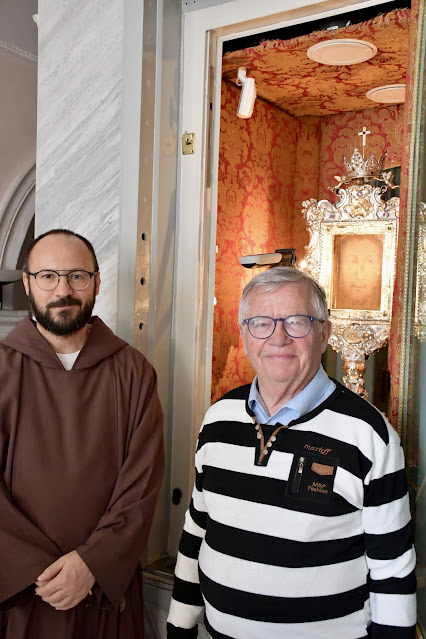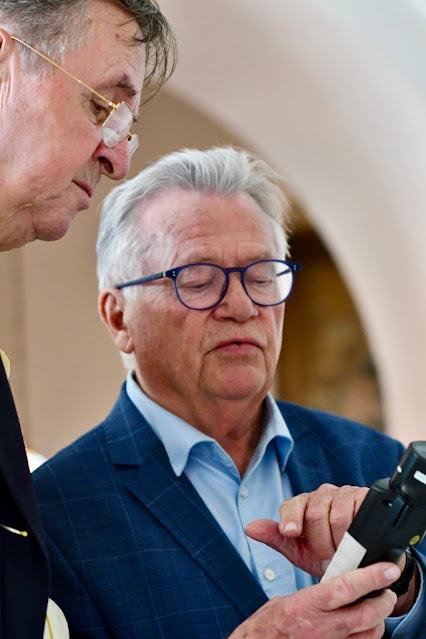 |
| Dr. Weth Measuring Beta Radiation |
“Manoppello’s Holy Veil: Light of Faith for a New Jubilee”
https://www.ncregister.com/commentaries/manoppello-holy-veil-light-of-faith-for-a-new-jubilee
recounts some of the results of the examination of the Holy Face of Manoppello conducted by the medical researcher Dr. Gosbert Weth of Schweinfurt, Germany, senior physician and head of the hormone laboratory at the University of Würzburg. Regarding his findings Dr. Weth stated “As a doctor, I can see this person must have been severely tortured. Hematomas are clearly visible both on the nose and in the area of the right cheek. … Neither traces of color nor traces of blood can be detected on the image. … Other bodily fluids such as blood or sweat are not recognizable. This cloth can therefore only have been applied to a person who has already died.”
In addition the researcher also came to the following conclusions “All in all, there is only one explanation for the formation of the image of the sacred face. The atomic change from nitrogen (N14) to carbon (C14) must have occurred under the influence of an enormous neutron radiation (light energy). … The ‘image’ is therefore not due to the application of paint, but to the nuclear-altered fibers of the carrier material.”
In addition Dr. Weth was able to scientifically measure for beta radiation and found that the incidence of this radiation was “considerably higher in the protected basilica than outside.”
“The reason for this higher density of beta rays,” he concluded, “can only lie in the existence of the Volto Santo inside the basilica.”
 |
| Fr. Antonio Gentili and Dr. Gosbert Weth |
Paul Badde described further findings by Dr. Weth in a more detailed article published on the German language website https://de.catholicnewsagency.com/news/17597/das-heilige-gesicht-birgt-licht-in-sich-mediziner-untersucht-volto-santo-von-manoppello
In translation here is some of what he wrote “Dr. Weth came to the Papal Basilica of the Holy Face in Manoppello on the eve of the next Holy Year 2025, on September 26, with a special nuclear medicine measuring device for alpha, beta and gamma rays. Here, Rector Antonio Gentili from the Capuchin convent of the shrine willingly opened the armored glass door of the display case for him, in which the Holy Sudarium has been sealed in its reliquary since 1714 between two crystal panes in a frame made of walnut and fish glue.”…
According to Dr. Weth “We therefore tried to measure the beta radiation released by the Manoppello cloth. This was not so easy because the cloth is enclosed between two glass plates. Nevertheless, we were able to measure this radiation, which took place around two thousand years ago and of which around 50% has already been consumed.”…
 |
| Paul Badde and Dr. Weth |
Dr. Weth continued: “This background radiation at the image veil was significantly higher than outside in nature. We therefore tried to measure this background radiation as precisely and as closely as possible. If we held the measuring device to the side of the reliquary, i.e., to the left and right where there was no glass shielding, there was an approx. 40 percent increase in beta radiation as a result of the conversion of carbon C14 to nitrogen N14. Overall, this beta radiation, which is also present everywhere outside in nature, was considerably higher in the protected basilica than outside. This is actually a contradiction. The reason for this higher density of beta rays can only lie in the existence of the Volto Santo inside the basilica.”
The complete translation of Paul Badde’s German language article is posted below
"The Holy Face contains light: Doctor examines “Volto Santo” of Manoppello"
By Paul Badde
In the first ever Holy Year, which Pope Boniface VIII (1294-1303) introduced as a Christian jubilee year for the year 1300, the most important destination for all pilgrims to Rome was not the Pope or even the tombs of the apostles, but a wafer-thin veil with the face of Christ. This was the Holy Sudarium. The veil was the greatest treasure of St. Peter's Basilica, which was called “Sanctum Sudarium” in Latin and also known as “Veronica.” The relic was considered to be the Holy Sudarium from the tomb of Christ, which was first mentioned in the account of the resurrection of St. John the Evangelist together with the long linen cloth, which is known as the Holy Shroud (or Santa Sindonde) venerated in Turin. In January 1208, Pope Innocent III carried this Holy Sudarium barefoot in a crystal monstrance for the first time in Rome, from St. Peter's Basilica to the nearby Santo Spirito in Sassia Hospital, thus making it publicly known throughout the Catholic world of the West. Since 1620, the same cloth has been venerated as the “Holy Face” (Volto Santo) in a Capuchin church on a hill outside Manoppello on the slopes of the Majella massif in Abruzzo, where Benedict XVI became the first pope to visit it after four hundred years on September 1, 2006. It is a material with many mysteries. And it is a subject that has also puzzled Gosbert Weth from Schweinfurt in Germany ever since he heard about it and saw photos of the veil.
Gosbert Weth is 78 years old, former chief physician, Doctor of Medicine, and Doctor of Natural Sciences (chemistry) with a storied academic career. As a senior physician and head of the hormone laboratory at the University of Würzburg, he worked on the world's largest centenarian study with 575 centenarians. He has developed groundbreaking developments for tumor therapies, been awarded the German Inventor Prize as the holder of several patents and has spoken at several world congresses on the topics of geriatrics and gerontology. Today, he is involved in research into new uses for hydrogen and is a doctor for hopeless cases in Bad Kissingen.
However, because he was convinced that the true “image” on the Holy Sudarium cannot have a chemical or a technical cause by a painter, Dr. Weth came to the Papal Basilica of the Holy Face in Manoppello on the eve of the next Holy Year 2025, on September 26, with a special nuclear medicine measuring device for alpha, beta and gamma rays. Here, Rector Antonio Gentili from the Capuchin convent of the shrine willingly opened the armored glass door of the display case for him, in which the Holy Sudarium has been sealed in its reliquary since 1714 between two crystal panes in a frame made of walnut and fish glue. That day, the memorial of the holy doctors of medicine Saints Cosmas and Damian in the Catholic Church is when the doctor from Bad Kissingen spent two hours in the basilica for his examinations during the lunch break of the monks and another hour the following Saturday for his examinations.
His initial conclusion was this: “As a doctor, I can see this person must have been severely tortured. Hematomas are clearly visible both on the nose and in the area of the right cheek. Intensive blows are necessary to cause these hematomas, which are always assessed as serious injuries in medical examinations. Neither traces of color nor of blood can be detected on the image which therefore can only have come into existence after his death. There is a pronounced hematoma on the nose (on the left side), which must be older than about 2 to 3 days. Other bodily fluids such as blood or sweat are not recognizable. This cloth can therefore only have been applied to a person who has already died. A double hematoma can also be seen in the area of the right cheek. Normally, as is still the case in medicine today, the eyes of every dead person are closed. The man in this portrait, however, has his eyes wide open. This image is an inexplicable phenomenon.”At the end of his investigation, however, Dr. Weth recorded the following: “All in all, there is only one explanation for the formation of the image of the sacred face. The atomic change from nitrogen (N14) to carbon (C14) must have occurred under the influence of an enormous neutron radiation (light energy). The light energy present in the veil is atomic evidence of the transformation of nitrogen (N14) into carbon (C14). As the carbon is dark in color, the image is deposited as dark matter in the cloth. This also explains the alternating shades of color. The 'image' is therefore not due to the application of paint, but to the nuclear-altered fibers of the carrier material.”
In this context, we must remember that, unlike light rays, most rays are invisible, but in many cases extremely powerful - such as electromagnetic X-rays or the almost invisible infrared light. All of these rays are full of energy.
Dr. Weth continues: “The radiocarbon method provides evidence that carbon C14 has been formed. Carbon C14 decays with a half-life of 5730 years into nitrogen N14 with the release of beta radiation, which is produced during the radioactive decay of atomic nuclei. The formation of carbon C14 leads back to nitrogen N14. Since carbon is dark, this image is also dark-colored and optically visible due to the conversion of nitrogen to carbon. So once again: The image on Manoppello's cloth was not created by coloring, but by an atomic change in the nitrogen molecules present in the organic substance.
We therefore tried to measure the beta radiation released by the Manoppello cloth. This was not so easy because the cloth is enclosed between two glass plates. Nevertheless, we were able to measure this radiation, which took place around two thousand years ago and of which around 50% has already been consumed.
We know that the decay of carbon C14 under beta radiation into nitrogen N14 decays by half within 5730 years. It should therefore still be possible to measure this radiation. And this was indeed the case.
This background radiation at the image veil was significantly higher than outside in nature. We therefore tried to measure this background radiation as precisely and as closely as possible. If we held the measuring device to the side of the reliquary, i.e., to the left and right where there was no glass shielding, there was an approx. 40 percent increase in beta radiation as a result of the conversion of carbon C14 to nitrogen N14. Overall, this beta radiation, which is also present everywhere outside in nature, was considerably higher in the protected basilica than outside. This is actually a contradiction. The reason for this higher density of beta rays can only lie in the existence of the Volto Santo inside the basilica.
The radiating of the Manoppello cloth at night can also be explained by this. It is glowing in the dark because energy is released during the conversion of C14 to nitrogen N14, which is not only released from light quanta, but also from electrons, as they are raised to higher orbitals in a conventional lamp. When the electrons fall back to their orbitals, light is released, which explains the glow of the cloth of Manoppello at night.”
In one sentence: the Holy Face contains light. The “True Icon” (Vera Eikon), as the veil has been called for centuries, radiates from within itself. This image veil is therefore not only identical to the Holy Sudarium from Jerusalem and the “Veronica” from Rome. It is “the human face of God,” of which Pope Benedict XVI has repeatedly spoken - and also a source of energy that inexplicably fills even the church interior, where rays should not normally be measured at all.
Basically, the experience that the Volto Santo is a source of power is nothing new. It is familiar to almost every pilgrim who has ever visited the shrine. Since the examination of the Doctor of Medicine, Doctor of Natural Sciences (Chemistry) Gosbert Weth before the next jubilee year, the statement is no longer a mere assertion, but a physical fact that can be measured.






No comments:
Post a Comment